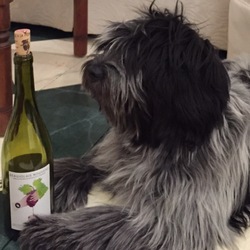Wines And Beverages Of Abkhazia
Weingut Riehen
Le Cidre - Riechner Epfel Basel-Stadt 2018



Mundus
Vinho Regional Lisboa White Blend
A trip down memory lane – Lisbon and all its wonders are reflected in this glass. Fernao Pires (45), Seara Nova (45%) and Moscatel-Gruado (10%).
Fermented in stainless steel with no oak. Straw-yellow in color, it has aromas and flavors of tropical fruit and citrus, but with a well-balanced dryness and acidity. It’s at once fresh and full of character, the perfect companion for a classic seafood dish from the Portuguese coast: a simply mixed fish grill with seasonal vegetables. Also amazing with chicken mole enchiladas from Mexico City Café.
Splash Wines: “For such a small country - only about the same overall size as Maine or Indiana - Portugal offers so much: history, culture, food, wine (not the least of which, with Port, is one of the world's most famous single beverages). The people are warm, generous, hardworking, and globally aware, with strong senses of both pride and humor about their place on the planet. How fortunate we are to have the chance to know them and their country through an industry that has really been surging in quality in recent years, as their reputation for making noble Port now extends to exceptional everyday whites and reds.
With a few exceptions, most of the grapes used in Portuguese wines are relatively unknown to the American wine drinker, and many were originally planted to be used in making port, or are a clone of one that was. It is home to hundreds of native grapes, and almost all bottled wines are blends of two or more. Both Vital and Seara Nova are traditional white grapes used in the area to the north and west of the capital city of Lisbon, previously called Estremadura, a long and thin region that runs along the Atlantic.”
— 4 years ago
Aramasa Brewery
Ecru Sake 2018
It's times like this when Aramasa makes me think of Keller. Notwithstanding that they both make completely different beverages, it is their ability to bring an incredible drinkability to their otherwise Herculean creations that evokes the comparability. In other words, power without weight. And, of course, I love both producers!
The Aramasa's Ecru is exceptionally pure, in the same light that KP's kabi's are. As Aramasa aptly describes it (and Google not-so-aptly translated it), "reminiscent of thawed water from some cold regions". I like to think that they're referring to pure glacial meltwater, but you get the gist. Even Aramasa's name for this cuvee is perfect - 'unbleached' purity.
Smells like pear, melon, flowers, light cream, and river stones. The palate has a light bittersweet character, which is so alike some mineral water. Trademark citrus acidity and phenolic grip. Finishes juicy, clean, and long. Mind-boggling lightness to what would otherwise be akin to engine oil in weight. In one phrase, a hyper elegant saké.
And oh, this is Aramasa's entry level cuvee too 🤯 — 6 years ago
Glenmorangie
12 Years Old The Lasanta Sherry Cask Extra Matured Single Malt Scotch
An excellent occasional tipple in winter. Glenmorangie are the masters of maturing in oak barrels which previously held other alcoholic beverages. They even mature in barrels that once held Sauternes. This Lasanta spent ten years maturing in American white oak ex-Bourbon casks before being matured for a further 2 years in Oloroso and PX Sherry casks from Jerez in Spain. This gives this single malt Scotch a sweet smoky slightly burnt nuance. — 2 years ago
Valdespino
Quina Jerez De La Frontera Pedro Ximénez
Perfecto!
An old, Chinchona infused vermouth that’s date, anise, bitter luscious.
Based on 20 yr. Oloroso.
W some soda on a hot day, pow!
@Delectable Wine : This is Valdespino Quina.
HISTORY
The history of the aperitif dates back to the 5th century B.C. when Hippocrates concocted a wine-based beverage macerated with wormwood flower and other herbs, which was traditionally used as a restorative and an appetite stimulant. In the late 1700s, in Italy, a flavored wine called "vermouth" was introduced as an appetite booster before meals. This tradition later spread to France and Spain.
In Spain, the aperitif and the "tapa" have together contributed to create a unique "social occasion" which has gradually become a key attraction for the general public and tourists worldwide; that is, the longstanding association of social gatherings with Spanish gastronomy.
The main difference between Spanish aperitifs (Vermouth and "Quina" or Tonic Wine, in particular) and their French and Italian counterparts lies in the quality of the aromatic flavors and the botanicals and fruits employed. Spanish aperitifs are somewhat sweeter and lighter, whereas Italian aperitifs are distinctive for their bitter flavor, while their French counterparts tend to be drier.
VALDESPINO AND
THE ORIGIN OF THE APERITIF
The connection between the Valdespino family and the aperitif dates back to the end of the 19th century and became especially relevant in the first quarter of the 20th century, at the height of the sherry wine boom.
By 1920 the House of Valdespino was already producing several wines macerated with root extracts and botanicals. They were called "tonics" and "quinados" and were recommended as "tonic – aperitifs" or "fortifiers", as shown on the labels of the time.
From 1930 until the second half of the 20th century, The House of Valdespino was particularly active in the production of beverages macerated with different botanicals, fruits and bitter root extracts (cinchona bark and vermouth). The company marketed several wines with considerable success, mainly on the domestic market but also in countries like the USA, where, in the 60s, Valdespino, together with their associate Jack Poust, launched a vermouth with orange called "Tomboe", designed mainly for the younger clientele.
Thanks to the boost provided at the time by the export of sherry wines to England and its overseas provinces, there was a boom in the production of wines made, or rather, macerated with the root of Cinchona Calisaya, whose bark, popularly called "quina", was the basis of quinine, an extract that contributed effectively to malaria prevention.
Since then, Valdespino has been macerating and bottling blends of different varieties of their own sherries.
THE ORIGIN OF
THE "JEREZ APERITIF"
The Estévez family, owners of Bodegas Valdespino since 1999, carried on with this tradition, and continued to macerate old wines from the different Valdespino soleras with various botanicals, natural extracts and fruits. These were small productions and batches, bottled for their own consumption, elaborated experimentally and in advance of what has now become the family's new collection.
The launching in 2021 of "Valdespino Aperitifs" represents an important milestone for the company, since it is a unique range in the Valdespino catalogue.
Valdespino's original "Tonic for the Sick" label, dating back over a century, has been selected in an attempt to recover some of the iconic designs from the family labels museum. The image, somewhere between Art Deco and vintage, has inspired the design, which is intended as a benchmark for today's aperitif ranges.
This is the first time that a Jerez winery has developed a collection of aperitifs by recovering old recipes and original labels from the early 20th century, using Very Old Oloroso Wines from the founding soleras of the Jerez firm, which today constitute our prized "VOS" and "VORS" (Sherry Wines of an average of over twenty and thirty years of age, respectively).
VERMOUTH
A coupage of Very Old Oloroso Sherry Wine (aged for 15 years) and Moscatel, which provides a stylish citrus note. After undergoing a hydro-alcoholic maceration process with bitter extracts of mugwort, coriander, elderberry and gentian, together with chamomile flowers, aromatic cloves, cinnamon, dried Seville oranges and juniper berries, the final blend is then aged in barrels which have previously contained Valdespino Oloroso Wines, all these coming together to make an intense and complex vermouth with a sumptuous balance of aromas.
This vermouth is a signature aperitif with an unmistakable identity characterized by the prominence of the Old Oloroso from Jerez, alongside an elegant dash of bitterness, which is offset by the sweetness of the Moscatel. The result is a subtly balanced taste with unique spicy and citrus notes provided by the botanicals and fruits.
Bright mahogany color with coppery tones.
Intense spicy aromas with hints of Oloroso Sherry.
Citrus notes from oranges, with a lovely, spiced blend of clove and gentian. An elegant, enveloping bitterness resulting in a complex yet smooth palate. Warm and welcoming, faintly sweet aftertaste.
Serve in a tumbler glass, with ice and a slice of grapefruit or orange. Ideal as an aperitif, accompanied by nuts, olives and pickles, it also combines superbly with canned fish tapas such as anchovies, pickled tuna and the like.
QUINA
This aperitif is the result of the coupage of 20-year-old Oloroso Wines with Pedro Ximenez from the soleras of our iconic PX "EL Candado". The procedure involves a hydro-alcoholic maceration process of Cinchona bark (Quina) with gentian root, natural licorice extract and nutmeg, along with a selection of dried citrus fruits, such as grapefruit and Seville oranges.
The result is a stylish, complex, one-of-a-kind aperitif with a bitter refreshing note. The Pedro Ximenez also provides a characteristic nuance of dried fruit (sultanas, dried figs, dates) that makes this tonic wine ever more unique.
A fresh and sweet palate with citrus and slightly tart notes, all wrapped up in a spicy combination of cloves, nutmeg, cinnamon, vanilla … leaning into the sweet reminders of the Oloroso Sherry barrels where it is aged.
Dark mahogany color with coppery tones.
Spicy aromas with vegetal notes from the botanicals and Oloroso Sherry.
Slightly bitter notes of Cinchona, combining well with the botanicals (licorice, nutmeg) and hints of dried fruits (dates, sultanas). A stylish citrus touch and the quinine bitterness bring about a warm, lingering aftertaste.
Ideal as a complement in cocktails (Rum Old Fashioned, Negroni, Mahattan, etc), it also makes for a perfect aperitif in a tumbler glass, on the rocks, with a cinnamon stick and a twist of orange.Serve with crisps, olives and pickles.
BODEGAS VALDESPINO
CTRA. N-IV, KM. 640 - 11408 - JEREZ, SPAIN
Bodegas Valdespino - All rights reserved 2021 — 3 years ago

I looked up that Syrah you posted, In U.S. I found 1 seller, in CO. Pick up only $53 Ha!

Daou Vineyards
Pessimist Paso Robles Red Blend 2021
Bought at Kauai Costco today…tag said 93 rating by one of the big raters. I wouldn’t score it that high at a food truck place in Koloa town. Drank out of cardboard coffee cups. If I had my nice stemware it probably would have scored higher. Under $20. It was OK to open our bottle at the dining tables. No adult beverages sold at any of the 3 food trucks. — 3 years ago
Clausthaler
Non-Alcoholic Lager
On medication and can't partake of alcohol, so finding new non- alcoholic beverages.
Nice lager, similar to a Stella in aroma and flavour. Crisp and flavourful.
86 calories per bottle with 18.5 grams of carbs.
Happy Friday to all! 😃
•0% ABV• April 21, 2023 🍻 — 3 years ago
Massican
Annia Napa Valley Tocai Friulano Blend 2018
Medium bodied white blend. Pear, pineapple with herbaceous notes on the nose. Crisp green apple, Bartlett pears, bright lime zest, reminiscent of effervescent beverages. Easy to sip, would be great on a summer evening. (Patty’s party chicken, sautéed green beans, side salad - on a Monday night) — 4 years ago
Great Notion Brewing
Berry Pusher
Great notion berry pusher tart ale. Insane! Was super skeptical but wow is this refreshing, sweet, creamy, and tart. I’m not sure I’d guess this was a beer but it is one of the best hot day beverages I’ve ever had. — 5 years ago
Ruinart
Brut Rosé Champagne
Celebrating finishing three weeks of work getting our rental ready, the 49ers win (Sofia was on edge that they would lose another close game last minute) and settling into the season.
The Ruinart is Sofia’s favorite N/V Rosé champagne...at least tonight!
I do enjoy it for its, deeper, dark, rich fruits of; black cherries, cherries, strawberries with whip cream, raspberries, summer season, ripe & juicy watermelon, touch of tangerine, citrus, sea fossils, grey volcanic minerals, hints of white spice, round, crisp, penetrating chalkiness, bread, notes of gummy candies and pink roses pedals. The acidity is fresh & bright. The rich, well balanced & polished finish is delicious.
Happy season everyone. Hope you are enjoying it along with your favorite wines and or beverages. Cheers! 🍾🥂🍷🎅⛄️❄️🎁🎄
Does anyone else have a candle tree? So great! We miss Illuminations! — 6 years ago












Lyle Fass

Founder Fass Selections
The nose is just the most incredible thing and if the palate wasn’t so delicious I’d be smelling this cider till the pigs come home. It’s smokey. But smokey in a smoked applewood type of way. It’s got green apple, red apple, and the aromas are mostly green and red apple skins and not the flesh. It’s not floral but has that same floral effect a floral red or white wine has in that it’s expansive and has a bouquet but these “floral” aromas are more like leaves. Fresh, gorgeous leaves. It’s so uncanny how complex this nose is. The nose also has hickory and iodine and I yelled out “This!! This is what would happen if you made Puligny Montrachet from apples!” I was so proud of myself. It’s got that Puligny iodine, sweet hazelnut thing and a kind of florality from the combo of apple skins and leaves. It’s just insane. After maybe 25-45 minutes of air this develops some quince, apricots and spice aromas that only add to the allure.
The palate is so juicy. I mean this is juicy and delicious like nothing else. It’s so explosive and just bursting with the purest green and red apple flavors one can imagine. It’s absurd. Nearly religious experience as you cannot comprehend how apples can be fermented into something that is at once contemplative and also insanely delicious. It’s delicious like ice cream you cannot stop eating. There are few wines like this and even fewer beverages. It’s so pure and so refined with just incredible finesse. The palate has these amazing candied apples that I have never experienced before in my life. These candied apples in this cider have to be tasted to be believed. There are also flavors of brioche and sourdough bread. There is a hint of sweetness but it’s like the sweetness one gets when one bites into a ripe, juicy perfect mid season apple. This is so so juicy and so clean. I mean this is as clean as any beverage I have ever had. The finish goes on forever and ever and finished with spice, complexity, green apple skins, green leaves, hazelnuts and iodine. This is absolutely bonkers cider — a year ago